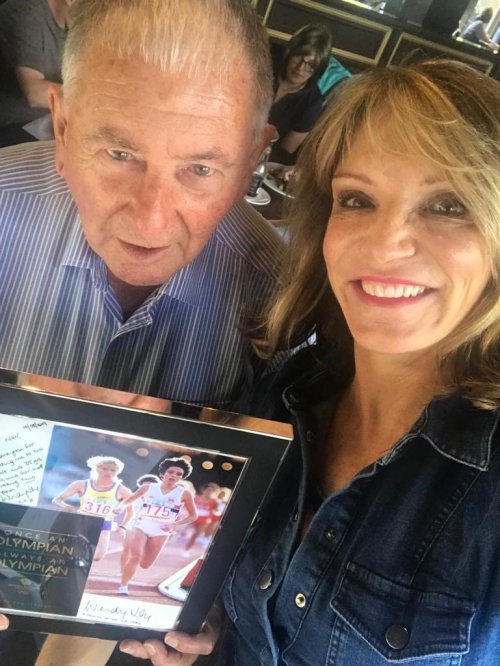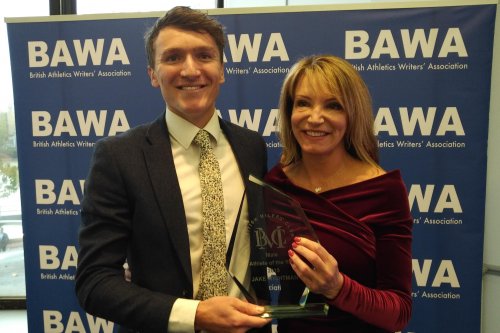 Coach Neil Taylor and Wendy Sly, photo by Wendy Sly
Coach Neil Taylor and Wendy Sly, photo by Wendy Sly
 Jake Wightman and Wendy Sly, photo by BAWA
Jake Wightman and Wendy Sly, photo by BAWA
Wendy Sly was the 1984 Olympic silver medalist at the 3000m. This is part 2 of the interview with Wendy Sly by Stuart Weir and her later career.
Wendy Sly part 2
In 1985 Sly was injured and not able to run, which was a major frustration as she had been in good shape and training well before the injury. “I would love to have been part of that season and the Mary Decker and Zola Budd rematch events, of which there were several. Where would I have finished in those races? Heaven only knows. I think I would have won some and lost some but it would’ve been some great racing”.
3000 meters was the longest race for women at the 1984 Olympics. 10,000m was introduced in 1988 and 5,000m replaced the 3,000 in 1996, which begs the question, what would be Wendy Sly’s best distance had the full range of races been available?
“I ran a couple of 10,000s on the track. 10,000 meter runners will tell you that you have to learn to race the 10K on the track. I’d run 31:29 on the road and some pretty decent 10Ks on the road so I think I would’ve been a good 10,000 track runner, once I had learned the event. I would love to have done a marathon but physiologically I’m quite injury prone so I would’ve had to have been careful with the training. Back then we didn’t get the strength and conditioning support, physiotherapy and massages that athletes get nowadays. So my hesitancy about the marathon is whether I could have made it to the start line because of my vulnerability to injury. I like to think I could have been a good 10,000m runner. I ran 31:53 having only run one or two before that. And, of course, it was a pretty new event at that time.
“I qualified for both 3,000m and 10,000m for the 1988 Olympics – but to show how things have changed – the selectors wouldn’t pick me for both because they didn’t think I was capable of running two 3,000m races and then a 10,000m. Of course, the generation of women athletes who followed on – Liz McColgan, Paula Radcliffe etc – showed that it can be done. But at that time I was a victim of that rather old-fashioned thinking”.
She has the distinction of winning the Fifth Avenue mile in 1983. “I loved the Fifth Avenue mile. I think I’m quite suited to running on the road, perhaps it’s the way I run. I ran New York in 1982 because I have not been picked for the European Championships, which broke my heart. I’d broken the British record earlier in the year at the Bislett Games 8:42. Then, I had a bit of a wobble in the middle of the summer. I got ill and ran a poor race at Crystal Palace and on that basis they didn’t take me. I was cross about that because it wasn’t about taking someone else. They just didn’t take me. But I got invited to run the Fifth Avenue mile and I absolutely loved it. I finished second but learned a few lessons about the tactics of running a road mile and the next year, I won it. The day after the 1983 race, I was on the front page of the New York Times and I have a poster with that picture on my office wall! The time was 4:22.9. That doesn’t seem great by today’s standards but at the time it was quite quick! It was a fabulous event to end the season, great atmosphere in New York City with a big crowd and great camaraderie among the runners. Now it’s become a mass participation event. Perhaps I should go back and see how slowly I can run a mile these days!! Probably double my winning time”.
When she stopped running, she worked for a magazine called AthleticsToday and then created a career for herself working for companies like Ziff-Davis and Reader’s Digest, where she was circulation director. Then she worked as a consultant and for Seb Coe’s Complete Leisure Group before taking on her current job as managing director of Great Run Publishing which owns Athletics Weekly. She says of her current job: “I have effectively come full circle. The job is a combination of all my skills acquired over 30-40 years – running, knowing people in the sport, understanding publishing and learning about social media. It’s a great job and a great combination of things I’ve done the past”.
Author

Larry Eder has had a 52-year involvement in the sport of athletics. Larry has experienced the sport as an athlete, coach, magazine publisher, and now, journalist and blogger. His first article, on Don Bowden, America's first sub-4 minute miler, was published in RW in 1983. Larry has published several magazines on athletics, from American Athletics to the U.S. version of Spikes magazine. He currently manages the content and marketing development of the RunningNetwork, The Shoe Addicts, and RunBlogRun. Of RunBlogRun, his daily pilgrimage with the sport, Larry says: "I have to admit, I love traveling to far away meets, writing about the sport I love, and the athletes I respect, for my readers at runblogrun.com, the most of anything I have ever done, except, maybe running itself." Also does some updates for BBC Sports at key events, which he truly enjoys. Theme song: Greg Allman, " I'm no Angel."
View all posts





















